Abstract
Spin qubits are very valuable and scalable candidates in the area of quantum computation and simulation applications. In the last decades, they have been deeply investigated from a theoretical point of view and realized on the scale of few devices in the laboratories. In semiconductors, spin qubits can be built confining the spin of electrons in electrostatically defined quantum dots. Through this approach, it is possible to create different implementations: single electron spin qubit, singlet–triplet spin qubit, or a three-electron architecture, e.g., the hybrid qubit. For each qubit type, we study the single qubit rotations along the principal axis of Bloch sphere including the mandatory non-idealities of the control signals that realize the gate operations. The realistic transient of the control signal pulses are obtained by adopting an appropriate low-pass filter function. In addition. the effect of disturbances on the input signals is taken into account by using a Gaussian noise model.
1. Introduction
The confinement of electron spins in host semiconductors is intensely studied in view of powerful applications in quantum computation and simulation [1,2,3,4]. Largely studied are qubit defined in electrostatically or self-assembled QDs [5,6,7], donor spins in solid matrices [8,9,10] or a combination of them [11,12]. In particular, semiconductor-based qubits assure long electron spin coherence times, easy manipulation, fast gate operations, and potential for scaling, in addition to the compatibility with the existing CMOS process. Starting from analytical expressions for the realization of logical gates, which are rotations along the main axis on the Bloch sphere, we study how such operations are affected when non-idealities are included in the control pulses. The control and the manipulation of the qubit need electric voltages or magnetic fields, using DC pulses or microwave drives depending of the qubit type. We focus our study on three QD spin qubits: the single spin qubit [13], the singlet-triplet qubit [14] and the hybrid qubit [15].
The single spin qubit is realized confining the spin of a single electron in a single QD. The logical basis is defined adopting the two spin eigenstates and as the logical and , respectively. In a rotating frame, which rotates at the angular frequency , under the rotating wave approximation (RWA), the Hamiltonian is given by:
where is the Pauli operator, where is the Larmor angular frequency, is the Zeeman energy associated to the constant magnetic field applied in the z direction ( is the electron g-factor and is the Bohr magneton) and is the Zeeman energy associated to the oscillating magnetic field , with phase and angular frequency . Qubit manipulation is obtained by modulating the phase .
The singlet–triplet qubit is defined on states of two electrons confined in a double QD. The logical states are a superposition of two-particle spin singlet and triplet states, which are and , where each QD is occupied with one electron. The effective Hamiltonian model is
where and are the Pauli matrices referring to the two electrons. The first term on the right side is the Zeeman energy with , namely a magnetic field gradient between the QDs, and the second term is the exchange interaction through the coupling constant J. The ST qubit allows fast readout and fast manipulation as long as local magnetic gradients have been created through, for example, the use of a micro-magnet in close proximity.
The hybrid qubit is realized confining three electrons in a double QD. The logical states (coded in the and three-electron subspace) have been expressed by and , where combined singlet and triplet states of a pair of electrons occupying one dot with the states of the single electron occupying the other are used. The effective Hamiltonian model for single and two qubits was derived by Ferraro et al. [16] and by Ferraro et al. [17], respectively. For the single HY qubit, the effective Hamiltonian is
where () is the Pauli matrix of the i–th electron, is the Zeeman energy due to a constant global magnetic field used to initialize the qubit and the effective coupling constants , and J are explicitly derived in Reference [16]. The key advantage of this qubit relies on the all-electrical manipulation of the qubit that assures very fast operations.
The paper is organized as follows. Section 2 contains the presentation of the main results. The fidelities of the gate rotations and are calculated when the realistic transients of the control signal pulses are considered by adopting an appropriate filter function and the effect of the input disturbances is taken into account by using a Gaussian noise model. The rise and the fall edges of the realistic input signals are obtained by applying a first-order low-pass filter function to the ideal input signals. The low-pass filter with time constant , where is the frequency cutoff, defines the bandwidth of the realistic input signal. Section 3 contains a discussion about the main findings obtained. Finally, in Section 4, the nodal points related to the theory and the methods adopted are presented.
2. Results
We present for each spin qubit the results related to the single qubit gate operation and starting from the initial condition . The rotations are obtained through analytical input sequences that are reported in Appendix A [18]. We point out that the method is general and valid for arbitrary rotation angles as well as any initial condition. Moreover, the sequences are determined in such a way that each step time has to be longer than 100 ps, a value that represents a current reasonable experimental limit.
2.1. and with Bandwidth-Limited Pulses
Figure 1 shows a pictorial representation of the gate operations and on the Bloch sphere starting from the initial condition represented by the blue arrow. The results of both rotations are represented by the red arrows and the final state reached is explicitly written.
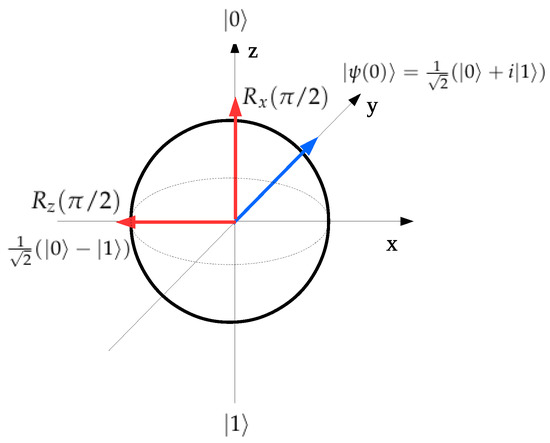
Figure 1.
Bloch sphere. The blue arrow represents the initial condition. The red arrows represent the final conditions after the and gate operations.
In the next subsections devoted to single spin (SS), singlet–triplet (ST) and hybrid (HY) qubits, respectively, we report gate infidelities as a function of the rotation angle and the time constant of first-order low-pass filter function without and with the effects of the input disturbances.
2.1.1. Single Spin Qubit
In the single spin qubit, the signal sequences for the rotations along x and z axes differ from the number of the steps. While needs only one step, needs three steps where the x and y components of the oscillating magnetic field are obtained by modifying its phase (see Table A1).
In Figure 2, we report (left) and (right) infidelity as a function of and when bandwidth-limited input signals are considered.
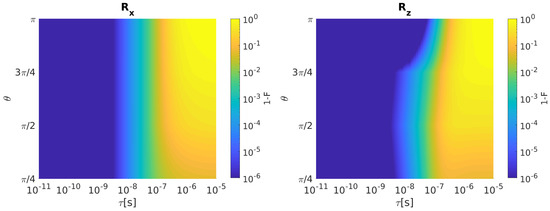
Figure 2.
SS qubit. (Left) Infidelity as a function of and when bandwidth-limited input signals are considered. (Right) The same for . Qubit parameters: = 1 MHz, = 0.
Both and infidelities increase as grows for all the considered rotation angles . Note that fidelity degrades more slowly for than other rotation angles as increases.
Inclusion of the input signal disturbances in our calculations gives the results reported in Figure 3 for the SS qubit. Here, by using a filter time constant of ps, we present (left) and (right) infidelity as a function of when undisturbed (solid line, blue) and disturbed (dashed line, red) input signals are considered.
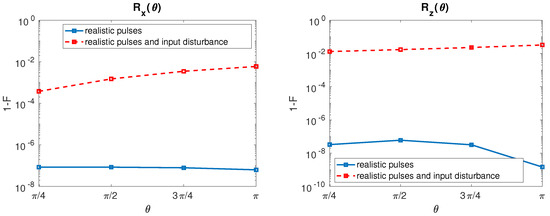
Figure 3.
SS qubit. (Left) infidelity as a function of when undisturbed input signals (solid line, blue) and disturbed input signals with = 0.05 MHz [7] and = 20 Hz [19] (dashed line, red) are considered. The value of is fixed to 100 ps. (Right) The same for .
Both and fidelities are heavily deteriorated by the input disturbances. Disturbed shows an increased infidelity as grows due to the fact that control sequence times for large are longer than those for small . As a result, input disturbances are integrated for longer times and gate fidelity worsen. The same comment holds for but with a mild infidelity increase as augments.
2.1.2. Singlet–Triplet Qubit
In the singlet–triplet qubit, the signal sequences for the rotations along x and z axes are reported in Table A1. is obtained operating in one step with the input , while needs two steps that include also the manipulation of the exchange coupling J.
Figure 4 shows (left) and (right) infidelity as a function of and .
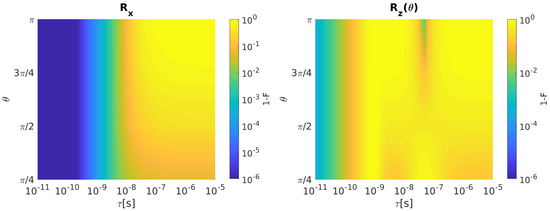
Figure 4.
ST qubit. (Left) Infidelity as a function of and when bandwidth-limited input signals are considered. (Right) The same for . Qubit parameters: J = 700 neV, = 32 neV [20].
and infidelities increase as grows for all the considered rotation angles. After the inclusion of the input disturbances, the resulting ST qubit infidelities for both rotations with ps are reported in Figure 5.
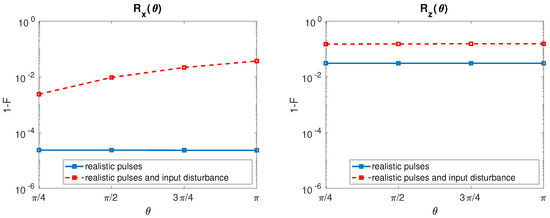
Figure 5.
ST qubit. (Left) Infidelity as a function of when undisturbed input signals (solid line, blue) and disturbed input signals with = 1 neV, = 4 neV [20] (dashed line, red) are considered. The value of is fixed to 100 ps. (Right) The same for .
As for the single spin qubit, singlet–triplet qubit rotations and show a strong fidelity degradation when input disturbances are included. infidelity grows as increases, whereas infidelity is not sensitive to variations.
2.1.3. Hybrid Qubit
The rotations along x and z axes for the hybrid qubit are realized through signal sequences involving the effective exchange couplings J, and . They are multi-step sequences composed, respectively, by two and three steps (see Table A1).
As it is evident in Figure 6, infidelity increases as grows for almost all the considered rotation angles. An infidelity reduction is observable for = in correspondence to > 1 ns. infidelity instead shows a more complex behavior than . 1-F increases for all as augments until roughly 100 ps. When is set between 100 ps and 1 ns, some local minima in the infidelity can be observed at different . For > 1 ns, infidelity is very high (larger than ) and constant below = /2, whereas it decreases for rotation angles above /2.
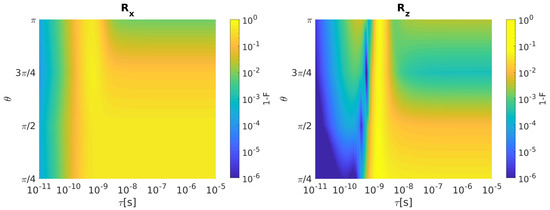
Figure 6.
HY qubit. (Left) Infidelity as a function of and when bandwidth-limited input signals are considered. (Right) The same for . Qubit parameters: = = 1 eV, J = 0.5 eV [21].
After inclusion of the input disturbances, the resulting HY qubit infidelities for both rotation with ps are reported in Figure 7.

Figure 7.
HY qubit. (Left) Infidelity as a function of when undisturbed input signals (solid line, blue) and disturbed input signals with = 80 neV [22] (dashed line, red) are considered. The value of is fixed to 100 ps. (Right) The same for .
Hybrid qubit rotation shows a weak fidelity degradation with respect to the undisturbed case, in addition a slight degradation of the fidelity can be observed as increases. Conversely, infidelity is strongly affected by the input disturbances in the entire range of studied with a weak additional degradation for large .
2.2. Fidelity Comparison
A comparison of the three spin qubit under study is here shown. The infidelity behavior as a function of is analyzed for (Figure 8) and (Figure 9). The results are presented when undisturbed pulses are considered (left) and when input disturbances are included (right). For both operations, we observe that the fidelity decreases when grows.

Figure 8.
infidelity as a function of for SS (solid line, blue), ST (dashed line, red), HY (dot-dashed line, green) qubit and No-Operation (dotted line, black): (Left) with undisturbed input signals; and (Right) with disturbed input signals.
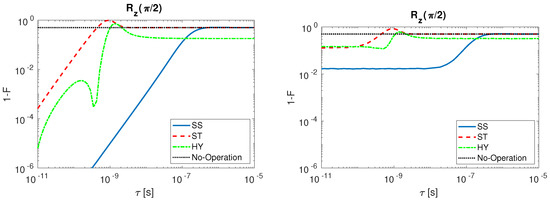
Figure 9.
infidelity as a function of for SS (solid line, blue), ST (dashed line, red), HY (dot-dashed line, green) qubit and No-Operation (dotted line, black): (Left) with undisturbed input signals; and (Right) with disturbed input signals.
From Figure 8, we may conclude that, setting the same initial condition for the gate operation considered, the SS qubit assures greater fidelities with respect to ST and HY qubit. We observe for the HY which has shorter sequences that is instead the most sensitive to variation. In the case in which also the input disturbance is included (right), we observe for SS and ST a saturated behavior when is reduced, and the HY fidelity also saturates but for smaller values of . The No-Operation curve describes the case in which the realistic pulses to perform the rotations are not applied. In this case the fidelity gives as a result , due to the reciprocal position of the initial and the ideal final qubit states on the Bloch sphere. When tau is large, the time variation of the control signal is so tiny that the qubit state is minimally rotated from the initial condition and thus we observe a saturated behavior of the infidelity to the value corresponding to No-Operation as tau increases.
The situation changes for (Figure 9) that is obtained with multiple step sequences (see Table A1). SS qubit is once again the most robust to variation, but, differently from , the most sensitive is the ST qubit. The HY qubit present local minima in the gate infidelity. Those local minima originate because selected gate sequences are not the shortest ones in absolute but they have to last longer than 100 ps. Such a step time elongation is obtained by increasing the parameter n (see Table A1) causing the qubit state to make additional complete rotations on the Bloch sphere during the step. When input signal sequences of such kind are filtered at a given , the consequential delay in the signal switching (on and off) generates partial rotations on the Bloch sphere that, if summed up to a 2 rotation, can lead to operations with low infidelity. The presence of an infidelity maximum in the ST qubit before the saturation to the No-Operation infidelity value (dotted line, black) is strictly connected to the nature of the multi-steps operation. The HY presents a similar behavior except from the fact that the infidelity does not reach the No-Operation value in the range of studied, since the operation requires that the exchange coupling J, which is not tunable from external gates, is always turned on during all the operations.
3. Discussion
As expected, when bandwidth-limited input signals for x and z rotations are considered, all the qubit types show a reduction of gate fidelities for increasing . Inclusion of signal amplitude disturbances further deteriorates the gate fidelity for reduced , also creating plateaus and leading to fidelities values in the range between 90% and 99.99%. The presence of local minima in the gate infidelities of HY qubit suggests that optimal working points can be identified achieving not only a reduced infidelity but even a simultaneous relaxation of the bandwidth requirements of the input system (larger ). By using parameter values at the state of the art, we can conclude that the hybrid qubit has the lowest infidelity provided that input signals with large enough bandwidth are available to achieve those fast sequences. Conversely, the single spin qubit shows low infidelities even at relatively high time constants due to the slow pulse times of its sequences.
4. Methods
The qubit dynamics is obtained solving the master equation for the total density matrix , where H is the effective qubit Hamiltonian () in the logical basis . The ideal gate sequences for and are analytically derived and reported in Appendix A.
The solution of the ideal dynamics, in which the applied pulses have ideal rise and fall edges (squared signals), is compared with the realistic situation, in which the rise and the fall edges of the input signals are described by a first-order low-pass filter function with time constant .
Moreover, the non-idealities of the input amplitudes are also included. Employing the quasi-static model, the errors on the input signals are modeled as random variables with Gaussian distributions featuring zero mean and standard deviation that add up to the ideal values. The figure of merit used to estimate the disturbance effects is the fidelity that measures how much the real state is distant from the ideal case.
Author Contributions
Conceptualization, E.F. and M.D.M.; Formal analysis, E.F. and M.D.M.; Investigation, E.F. and M.D.M.; Software, E.F. and M.D.M.; and Writing—review and editing, E.F. and M.D.M.
Funding
This research was funded by the European Union’s Horizon 2020 research and innovation program under grant agreement No. 688539 MOS-QUITO.
Conflicts of Interest
The authors declare no conflict of interest.
Abbreviations
The following abbreviations are used in this manuscript:
| QD | Quantum Dot |
| SS | Single Spin |
| ST | Singlet–Triplet |
| HY | Hybrid |
Appendix A. Analytical Gate Sequences
Table A1 contains the analytical gate sequences for all the spin qubit under study that realize in one or multiple steps the rotations and on the Bloch sphere [18].

Table A1.
Analytical gate sequences that realize (second column) and (third column). Each row refers to a qubit type.
Table A1.
Analytical gate sequences that realize (second column) and (third column). Each row refers to a qubit type.
| Qubit | ||
|---|---|---|
| SS | ||
| ST | with n integer | |
| HY | with , and | with and |
References
- Hanson, R.; Kouwenhoven, L.P.; Petta, J.R.; Tarucha, S.; Vandersypen, L.M.K. Spins in few-electron quantum dots. Rev. Mod. Phys. 2007, 79, 1217. [Google Scholar] [CrossRef]
- Vandersypen, L.M.K.; Bluhm, H.; Clarke, J.S.; Dzurak, A.S.; Ishihara, R.; Morello, A.; Reilly, D.J.; Schreiber, L.R.; Veldhorst, M. Interfacing spin qubits in quantum dots and donors—Hot, dense, and coherent. NPJ Quantum Inf. 2017, 3, 34. [Google Scholar] [CrossRef]
- Russ, M.; Burkard, G. Three-electron spin qubits. J. Phys. Condens. Matter 2017, 29, 393001. [Google Scholar] [CrossRef] [PubMed]
- Rotta, D.; Sebastiano, F.; Charbon, E.; Prati, E. Quantum information density scaling and qubit operation time constraints of CMOS silicon-based quantum computer architectures. NPJ Quantum Inf. 2017, 3, 26. [Google Scholar] [CrossRef]
- Loss, D.; DiVincenzo, D.P. Quantum computation with quantum dots. Phys. Rev. A 1998, 57, 120. [Google Scholar] [CrossRef]
- Veldhorst, M.; Hwang, J.C.C.; Yang, C.H.; Leenstra, A.W.; de Ronde, B.; Dehollain, J.P.; Muhonen, T.J.; Hudson, F.E.; Itoh, K.M.; Morello, A.; et al. An addressable quantum dot qubit with fault-tolerant control-fidelity. Nat. Nanotechnol. 2014, 9, 981–985. [Google Scholar] [CrossRef]
- Kawakami, E.; Scarlino, P.; Ward, D.R.; Braakman, F.R.; Savage, D.E.; Lagally, M.G.; Friesen, M.; Coppersmith, S.N.; Eriksson, M.A.; Vandersypen, L.M.K. Electrical control of a long-lived spin qubit in a Si/SiGe quantum dot. Nat. Nanotechnol. 2014, 9, 666–670. [Google Scholar] [CrossRef]
- Kane, B.E. A silicon-based nuclear spin quantum computer. Nature 1998, 393, 133. [Google Scholar] [CrossRef]
- Pla, J.; Tan, K.; Dehollain, J.; Lim, W.; Morton, J.; Jamieson, D.; Dzurak, A.; Morello, A. A single-atom electron spin qubit in silicon. Nature 2012, 489, 541. [Google Scholar] [CrossRef]
- Pla, J.J.; Tan, K.Y.; Dehollain, J.P.; Lim, W.H.; Morton, J.J.L.; Zwanenburg, F.A.; Jamieson, D.N.; Dzurak, A.S.; Morello, A. High-fidelity readout and control of a nuclear spin qubit in silicon. Nature 2013, 334, 496. [Google Scholar] [CrossRef]
- Pica, G.; Lovett, B.W.; Bhatt, R.N.; Schenkel, T.; Lyon, S.A. Surface code architecture for donors and dots in silicon with imprecise and nonuniform qubit couplings. Phys. Rev. B 2016, 93, 035306. [Google Scholar] [CrossRef]
- Harvey-Collard, P.; Jacobson, N.T.; Rudolph, M.; Dominguez, J.; Eyck, G.A.T.; Wendt, J.R.; Pluym, T.; Gamble, J.K.; Lilly, M.P.; Pioro-Ladrière, M.; et al. Coherent coupling between a quantum dot and a donor in silicon. Nat. Commun. 2017, 8, 1029. [Google Scholar] [CrossRef] [PubMed]
- Morton, J.J.L.; McCamey, D.R.; Eriksson, M.A.; Lyon, S.A. Embracing the quantum limit in silicon computing. Nature 2011, 479, 345–353. [Google Scholar] [CrossRef] [PubMed]
- Levy, J. Universal Quantum Computation with Spin-1/2 Pairs and Heisenberg Exchange. Phys. Rev. Lett. 2002, 89, 147902. [Google Scholar] [CrossRef] [PubMed]
- Shi, Z.; Simmons, C.B.; Prance, J.R.; Gamble, J.K.; Koh, T.S.; Shim, Y.P.; Hu, X.; Savage, D.E.; Lagally, M.G.; Eriksson, M.A.; et al. Fast Hybrid Silicon Double-Quantum-Dot Qubit. Phys. Rev. Lett. 2012, 108, 140503. [Google Scholar] [CrossRef]
- Ferraro, E.; De Michielis, M.; Mazzeo, G.; Fanciulli, M.; Prati, E. Effective Hamiltonian for the hybrid double quantum dot qubit. Quantum Inf. Process. 2014, 13, 1155–1173. [Google Scholar] [CrossRef]
- Ferraro, E.; De Michielis, M.; Fanciulli, M.; Prati, E. Effective Hamiltonian for two interacting double-dot exchange-only qubits and their controlled-NOT operations. Quantum Inf. Process. 2015, 14, 47–65. [Google Scholar] [CrossRef]
- Ferraro, E.; Fanciulli, M.; De Michielis, M. Gate fidelity comparison in semiconducting spin qubit implementations affected by control noises. J. Phys. Commun. 2018, 2, 115022. [Google Scholar] [CrossRef]
- Keysight, T. Keysight Technologies E8257D PSG Microwave Analog Signal Generator. 2017. Available online: https://www.keysight.com/en/pdx-x202237-pn-E8257D/psg-analog-signal-generator-100-khz-to-67-ghz (accessed on 25 October 2019).
- Wu, X.; Ward, D.R.; Prance, J.R.; Kim, D.; Gamble, J.K.; Mohr, R.T.; Shi, Z.; Savage, D.E.; Lagally, M.G.; Friesen, M.; et al. Two-axis control of a singlet—Triplet qubit with an integrated micromagnet. Proc. Natl. Acad. Sci. USA 2014, 111, 11938–11942. [Google Scholar] [CrossRef]
- De Michielis, M.; Ferraro, E.; Fanciulli, M.; Prati, E. Universal set of quantum gates for double-dot exchange-only spin qubits with intradot coupling. J. Phys. A Math. Theor. 2015, 48, 065304. [Google Scholar] [CrossRef]
- Thorgrimsson, B.; Kim, D.; Yang, Y.C.; Smith, L.W.; Simmons, C.B.; Ward, D.R.; Foote, R.H.; Corrigan, J.; Savage, D.E.; Lagally, M.G.; et al. Extending the coherence of a quantum dot hybrid qubit. NPJ Quantum Inf. 2017, 3, 32. [Google Scholar] [CrossRef]
© 2019 by the authors. Licensee MDPI, Basel, Switzerland. This article is an open access article distributed under the terms and conditions of the Creative Commons Attribution (CC BY) license (http://creativecommons.org/licenses/by/4.0/).